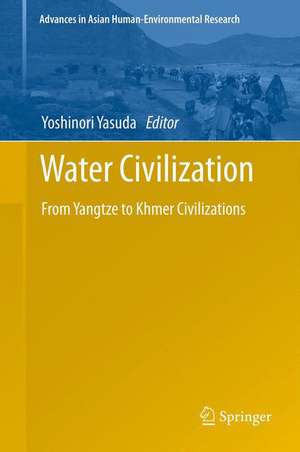Water Civilization: From Yangtze to Khmer Civilizations: Advances in Asian Human-Environmental Research
Editat de Yoshinori Yasudaen Limba Engleză Hardback – 24 oct 2012
| Toate formatele și edițiile | Preț | Express |
|---|---|---|
| Paperback (1) | 576.23 lei 38-44 zile | |
| Springer – 23 aug 2016 | 576.23 lei 38-44 zile | |
| Hardback (1) | 660.68 lei 6-8 săpt. | |
| Springer – 24 oct 2012 | 660.68 lei 6-8 săpt. |
Din seria Advances in Asian Human-Environmental Research
- 18%
 Preț: 949.77 lei
Preț: 949.77 lei - 18%
 Preț: 782.91 lei
Preț: 782.91 lei - 18%
 Preț: 941.16 lei
Preț: 941.16 lei -
 Preț: 390.47 lei
Preț: 390.47 lei - 15%
 Preț: 640.72 lei
Preț: 640.72 lei - 20%
 Preț: 559.99 lei
Preț: 559.99 lei - 24%
 Preț: 725.18 lei
Preț: 725.18 lei - 18%
 Preț: 781.99 lei
Preț: 781.99 lei - 15%
 Preț: 635.67 lei
Preț: 635.67 lei - 15%
 Preț: 641.68 lei
Preț: 641.68 lei - 18%
 Preț: 941.16 lei
Preț: 941.16 lei - 15%
 Preț: 630.66 lei
Preț: 630.66 lei - 20%
 Preț: 578.29 lei
Preț: 578.29 lei - 15%
 Preț: 642.97 lei
Preț: 642.97 lei - 18%
 Preț: 1021.55 lei
Preț: 1021.55 lei - 15%
 Preț: 635.34 lei
Preț: 635.34 lei - 18%
 Preț: 943.51 lei
Preț: 943.51 lei - 18%
 Preț: 1564.23 lei
Preț: 1564.23 lei - 15%
 Preț: 637.46 lei
Preț: 637.46 lei - 18%
 Preț: 889.47 lei
Preț: 889.47 lei - 15%
 Preț: 634.69 lei
Preț: 634.69 lei - 15%
 Preț: 640.53 lei
Preț: 640.53 lei - 15%
 Preț: 636.31 lei
Preț: 636.31 lei - 18%
 Preț: 947.58 lei
Preț: 947.58 lei - 15%
 Preț: 637.78 lei
Preț: 637.78 lei - 15%
 Preț: 640.22 lei
Preț: 640.22 lei - 18%
 Preț: 1016.18 lei
Preț: 1016.18 lei - 15%
 Preț: 635.85 lei
Preț: 635.85 lei - 15%
 Preț: 639.42 lei
Preț: 639.42 lei - 15%
 Preț: 636.99 lei
Preț: 636.99 lei - 18%
 Preț: 931.29 lei
Preț: 931.29 lei - 15%
 Preț: 639.42 lei
Preț: 639.42 lei
Preț: 660.68 lei
Preț vechi: 777.27 lei
-15% Nou
Puncte Express: 991
Preț estimativ în valută:
126.53€ • 130.36$ • 105.100£
126.53€ • 130.36$ • 105.100£
Carte tipărită la comandă
Livrare economică 24 februarie-10 martie
Preluare comenzi: 021 569.72.76
Specificații
ISBN-13: 9784431541103
ISBN-10: 4431541101
Pagini: 300
Ilustrații: XXII, 477 p.
Dimensiuni: 155 x 235 x 25 mm
Greutate: 1.12 kg
Ediția:2013
Editura: Springer
Colecția Springer
Seria Advances in Asian Human-Environmental Research
Locul publicării:Tokyo, Japan
ISBN-10: 4431541101
Pagini: 300
Ilustrații: XXII, 477 p.
Dimensiuni: 155 x 235 x 25 mm
Greutate: 1.12 kg
Ediția:2013
Editura: Springer
Colecția Springer
Seria Advances in Asian Human-Environmental Research
Locul publicării:Tokyo, Japan
Public țintă
ResearchCuprins
Discovery of the Yangtze River Civilization in China.- Decline of the Yangtze River Civilization.- Comparative Study of the Artifacts of Phum Snay Site and the Wat Bo Temples’s Pottery Collection Database.- Survey and Excavation of Phum Snay in 2007-2010.- Non-Ceramic Grave Goods from Phum Snay in the Context of Sociopolitical Development in Northwest Cambodia.- Human Skeletons Excavated from Phum Snay.- Zooarchaeology at Phum Snay, a Prehistoric Cemetery in Northwestern Cambodia.- Chemical Composition and Lead Isotope Ratios of Bronze Artifacts Excavated in Cambodia and Thailand.- Phum Snay and Its Significance in World History.- Climate Deterioration and Angkor’s Demise.- Vegetation Change in the Area of Angkor Thom based on Pollen Analysis of Moat Deposits.- Palaeoenvironment of the Areas Surrounding the Angkor Thom Moat Inferred from Entomological Analysis.- Reconstruction of an 8000-year Environmental History on Pollen Records from Lake Buyan, Central Bali.- Great East Asian Fertile Triangle. Central Bali.- Great East Asian Fertile Triangle.
Textul de pe ultima copertă
Water Civilization: From Yangtze to Khmer Civilizations comprises three major topics: 1) Discovery of the origin of rice agriculture and the Yangtze River civilization in southern China was mainly based on investigation of the Chengtoushan archaeological site, the earliest urban settlement in East Asia. The origin of rice cultivation can be traced back to 10000 BC, with urban settlement starting at about 6000 BP; 2) The Yangtze River civilization collapsed around 4200 BP. Palaeoenvironmental studies including analyses of annually laminated sediments in East and Southeast Asia indicate a close relationship between climate change and the rise and fall of the rice-cultivating and fishing civilization; and 3) Migrations from southern China to Southeast Asia occurred after about 4200 BP. Archaeological investigation of the Phum Snay site in Cambodia, including analyses of DNA and human skeletal remains, reveals a close relationship to southern China, indicating the migration of people from southern China to Southeast Asia. This publication is an important contribution to understanding the environmental history of China and Cambodia in relation to the rise and fall of the rice-cultivating and fishing civilization, which we call water civilization.
Caracteristici
This is the first book which shows the origin and development of rice cultivating civilization in relation to the water environment in the Southeast Asia This book presents a series of analyses conducted by various scientists in various fields and outlines an environmental history of East and Southeast Asia Archaeological papers provide a detailed first-hand information of material evidence (including the first detailed ceramic chronology), which is valuable for all researchers working in the East and Southeast Asia











